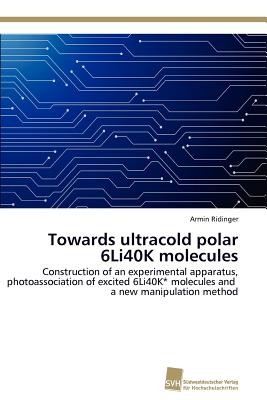
- We will send in 10–14 business days.
- Author: Ridinger Armin
- Publisher: Sudwestdeutscher Verlag Fur Hochschulschriften AG
- Year: 2011
- Pages: 240
- ISBN-10: 3838128958
- ISBN-13: 9783838128955
- Format: 15.2 x 22.9 x 1.4 cm, softcover
- Language: English
- SAVE -10% with code: EXTRA
Reviews
Description
Due to their low temperature of less than a milliKelvin and their long-range anisotropic interactions, ultracold polar molecules offer promising applications for quantum computing, the measurement of fundamental constants and ultracold chemistry and may allow the realization of new forms of quantum matter. The diatomic molecule 6Li40K is an excellent candidate for their implementation due to its large electric dipole moment. In this book, the author presents the first steps towards the creation of ultracold polar 6Li40K molecules. He gives a detailed description of the construction of an experimental apparatus which prepares, at ultracold temperatures, a gas mixture of the species 6Li and 40K. He demonstrates the association of these fermionic atoms to ultracold bosonic excited 6Li40K* molecules by photoassociation. The molecules will have to be transferred to their rovibrational and electronic ground state in order to become stable and polar. Photoassociation spectroscopy has been performed to gain information about convenient transfer schemes. Finally the author presents a novel method for the manipulation of ultracold particles, which can be applied to polar 6Li40K molecules.
EXTRA 10 % discount with code: EXTRA
The promotion ends in 20d.08:10:46
The discount code is valid when purchasing from 10 €. Discounts do not stack.
- Author: Ridinger Armin
- Publisher: Sudwestdeutscher Verlag Fur Hochschulschriften AG
- Year: 2011
- Pages: 240
- ISBN-10: 3838128958
- ISBN-13: 9783838128955
- Format: 15.2 x 22.9 x 1.4 cm, softcover
- Language: English English
Due to their low temperature of less than a milliKelvin and their long-range anisotropic interactions, ultracold polar molecules offer promising applications for quantum computing, the measurement of fundamental constants and ultracold chemistry and may allow the realization of new forms of quantum matter. The diatomic molecule 6Li40K is an excellent candidate for their implementation due to its large electric dipole moment. In this book, the author presents the first steps towards the creation of ultracold polar 6Li40K molecules. He gives a detailed description of the construction of an experimental apparatus which prepares, at ultracold temperatures, a gas mixture of the species 6Li and 40K. He demonstrates the association of these fermionic atoms to ultracold bosonic excited 6Li40K* molecules by photoassociation. The molecules will have to be transferred to their rovibrational and electronic ground state in order to become stable and polar. Photoassociation spectroscopy has been performed to gain information about convenient transfer schemes. Finally the author presents a novel method for the manipulation of ultracold particles, which can be applied to polar 6Li40K molecules.


Reviews